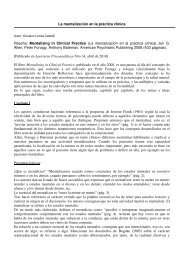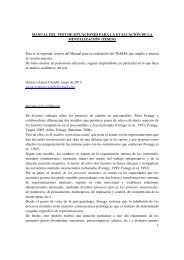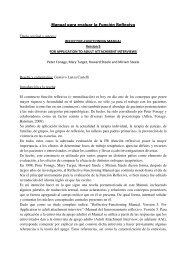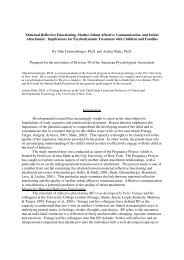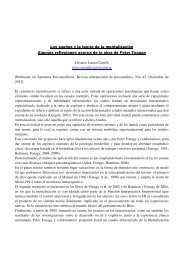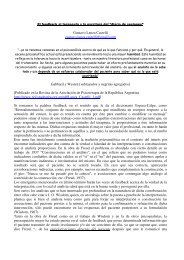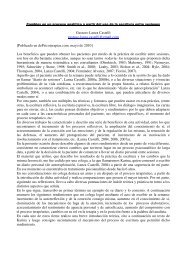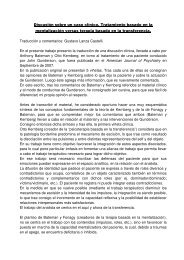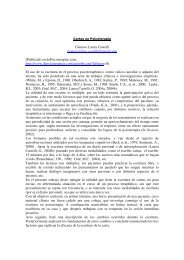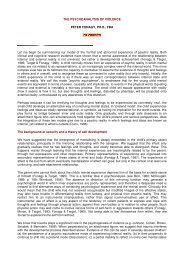Mentalization, Mental States and Affect Elaboration - mentalizacion y ...
Mentalization, Mental States and Affect Elaboration - mentalizacion y ...
Mentalization, Mental States and Affect Elaboration - mentalizacion y ...
You also want an ePaper? Increase the reach of your titles
YUMPU automatically turns print PDFs into web optimized ePapers that Google loves.
The Liberman Linguistic Styles Measure (LLSM)<br />
Styles Patient’s styles <strong>and</strong> analyst’s<br />
complementary responses<br />
1.<br />
Dramatic<br />
Aesthetic<br />
Theatrical<br />
2.<br />
Dramatic<br />
Suspense<br />
This demonstrative mode fascinates by<br />
the richness of expression. Metaphors,<br />
hyperboles, plastic images <strong>and</strong><br />
symbolism abound. Symbols of facts<br />
are used as if they were the facts<br />
themselves. The discourse may be<br />
equated to a dream. Castration anxiety<br />
is managed through projection,<br />
dramatization <strong>and</strong> the creation of an<br />
aesthetic impact. The subject tells<br />
stories that continually intend to<br />
captivate the attention. The listener<br />
becomes an observer of a dramatic<br />
scene, which seems to be happening<br />
right now. Here the analys<strong>and</strong><br />
defends against painful affects by<br />
becoming a seductive raconteur<br />
Analyst’ s complementary style. The<br />
schizoid- reflective attitude helps the<br />
analyst to perceive <strong>and</strong> put into abstract<br />
words the patients’ autoplastic,<br />
dramatized activity, <strong>and</strong> his dissociated<br />
or inhibited “mute parts”. Moving away<br />
from being a captive spectator, the<br />
reflective function invites the patient to<br />
reflectively observe his inner mental<br />
scene.<br />
This style has the worst syntax.<br />
Sentences are interrupted in the middle<br />
in an attempt to repress certain themes,<br />
as a result of a manifest phobic anxiety.<br />
The first person (I) pronoun is avoided.<br />
The effect on the listener is one of<br />
confusion, misunderst<strong>and</strong>ing <strong>and</strong><br />
obscurity. This can be reversed when<br />
patients are able to get in touch with<br />
their repressed unconscious wishes.<br />
This generates new symbolic meanings<br />
in phrases with optimal syntax.<br />
Analyst’s style (<strong>and</strong><br />
countertransference) as<br />
expressed in the analytic<br />
situation<br />
The dramatic aesthetic analyst<br />
names the patients’ internal<br />
contents in a symbolic <strong>and</strong><br />
imagistic manner, linking the<br />
affect <strong>and</strong> the representation.<br />
Interventions are rich in visual<br />
<strong>and</strong> plastic contents. Some<br />
exhibitionistic wishes may be<br />
gratified. Within an oedipal<br />
transference countertransference<br />
situation, the analyst’s<br />
seductiveness <strong>and</strong> its impact on<br />
the patient may be lost to the<br />
analyst’s observing ego.<br />
The phobic (dramatic suspense)<br />
analyst may avoid making<br />
transference interpretations when<br />
these involve themes which<br />
activate unconscious fantasies<br />
generating conflict <strong>and</strong> anxiety<br />
within the countertransference.<br />
Long, ambiguous sentences<br />
containing several interpolated<br />
clauses which leaves unclear<br />
which is the most important<br />
phrase are observed. The patients’



